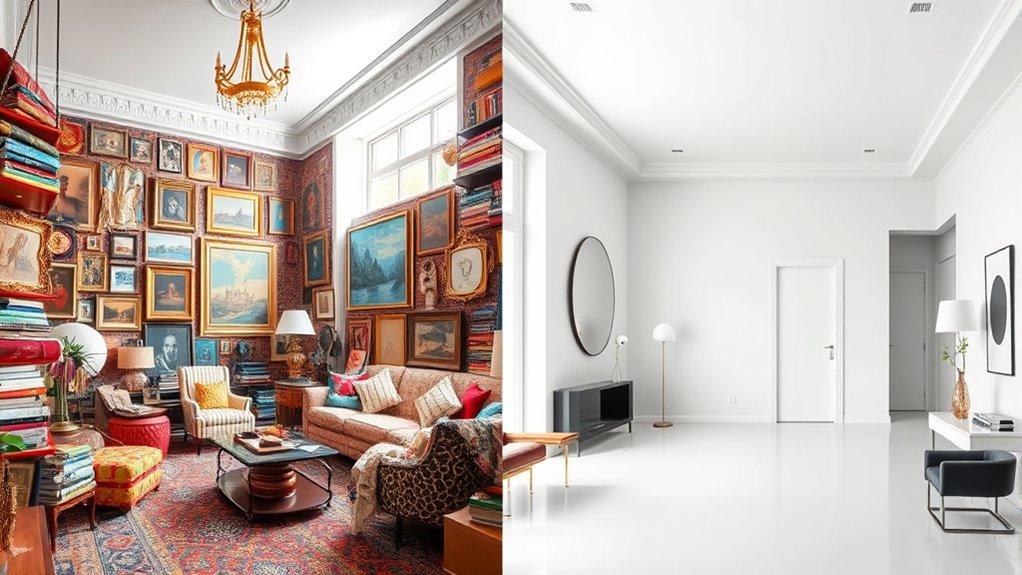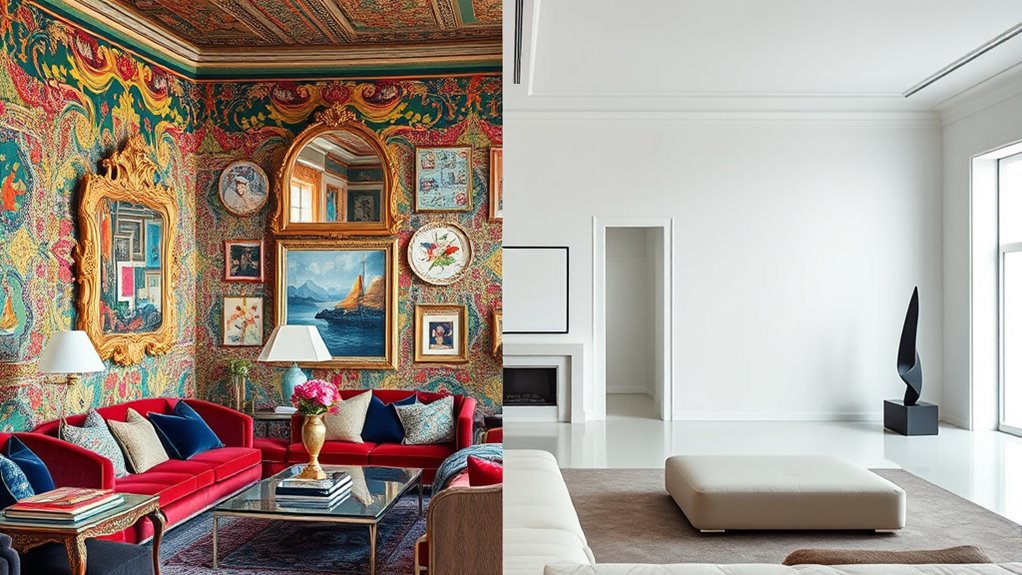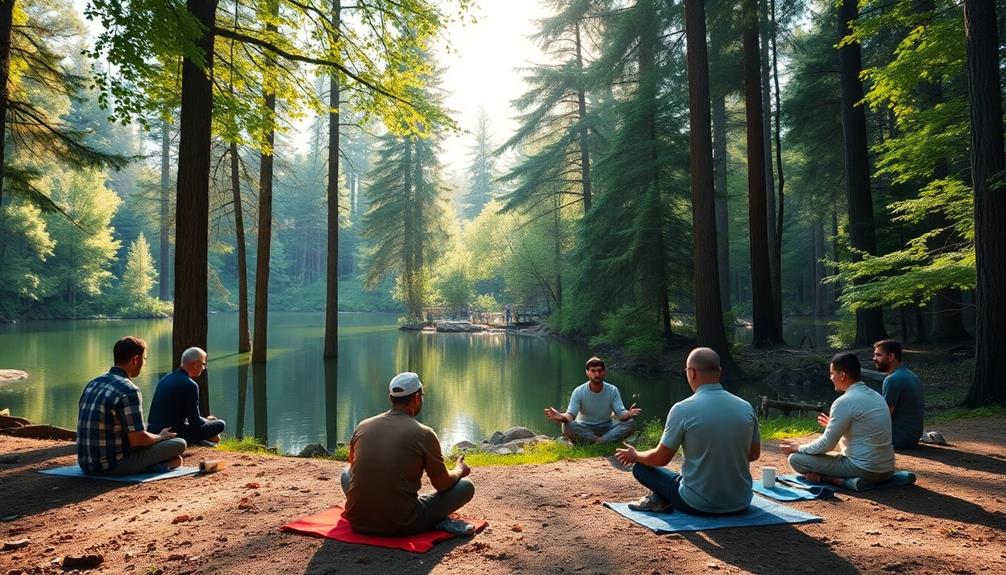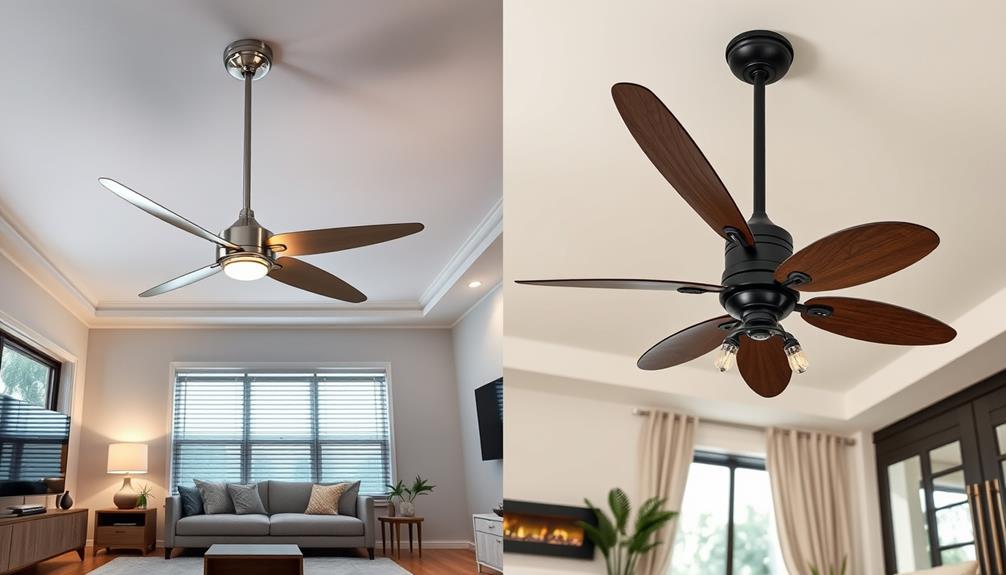Maximalism and minimalism in decor reflect very different personalities and moods. Maximalism embraces bold colors, rich textures, and layered objects to create a lively, eclectic space full of personality and visual interest. Minimalism, on the other hand, favors clean lines, neutral tones, and clutter-free simplicity for a calm, serene environment. Your choice depends on whether you want an energetic or calming atmosphere. Keep exploring to discover which style truly suits your personality and space.
Key Takeaways
- Maximalism features bold colors, layered textures, and an eclectic mix, creating a vibrant, energetic space.
- Minimalism emphasizes simplicity, clean lines, neutral palettes, and uncluttered environments for calm and clarity.
- Maximalist decor embraces abundance and visual complexity, while minimalism focuses on restraint and functional elegance.
- Material choices differ: maximalism uses diverse textures and finishes, whereas minimalism favors sustainable, high-quality materials.
- The emotional impact varies: maximalism energizes and personalizes, minimalism fosters tranquility and serene order.

When it comes to interior decor, the debate between maximalism and minimalism often boils down to personal style and how you want your space to feel. If you lean toward maximalism, you’ll find yourself embracing a rich tapestry of textures and an adventurous approach to color palettes. Texture variety becomes your playground — mixing velvety cushions, woven throws, glossy ceramics, and matte finishes to create a layered, tactile experience. This approach invites touch and visual intrigue, making your space lively and inviting. Bright, bold colors or a carefully curated mix of hues often define maximalist decor, allowing you to express your personality vividly. You might combine jewel tones with metallic accents, or juxtapose contrasting shades to keep things dynamic. This vibrant palette works hand-in-hand with texture variety, amplifying the sense of abundance and complexity. Additionally, incorporating unique and wicked planters can add an element of surprise and creativity to your maximalist space, further emphasizing your distinctive style.
On the other hand, minimalism champions simplicity and restraint. You’ll focus on a pared-down color palette — often neutral tones like whites, grays, and beiges — that promotes calm and clarity. Texture still matters, but it’s used more sparingly to add subtle interest without overwhelming the senses. Think of a smooth marble countertop paired with a soft linen sofa or a wooden accent wall with sleek metal fixtures. The key is choosing a few quality pieces that serve as focal points, avoiding clutter and excess. This approach emphasizes clean lines and open space, creating an atmosphere of serenity. You might opt for a monochromatic palette with slight variations in tone, which adds depth without sacrificing the minimalist aesthetic. Selecting sustainable materials can also enhance the minimalist ethos by emphasizing quality and longevity over excess.
Both styles require intentionality but differ greatly in execution. Maximalism demands a confident eye for mixing textures and bold color combinations, making your space feel energetic and personalized. Minimalism asks for restraint and careful curation, where each piece plays a role and nothing feels extraneous. If you prefer a cozy, eclectic vibe full of visual surprises, maximalism could suit you perfectly. If you value calm, order, and understated elegance, minimalism might be more your speed. Ultimately, your choice depends on how you want your space to evoke emotion and reflect your personality. Whether you go all-in with layered textures and vibrant palettes or embrace simplicity with subtle textures and muted colors, the key is making your environment feel authentic and comfortable for you.
Frequently Asked Questions
How Do I Transition From Minimalism to Maximalism?
To shift from minimalism to maximalism, start by embracing a decor style evolution that adds personality and layers. Incorporate bold patterns, vibrant colors, and varied textures, balancing aesthetics with your space. Gradually introduce statement pieces and art that reflect your personality. Don’t rush—allow your space to evolve naturally, blending simplicity with richness. The key is to create a curated, inviting environment that feels lively yet balanced.
Can Mixed Styles Work Within a Single Space?
Sure, mixed styles can work beautifully if you master eclectic harmony and style blending. Imagine a room where a vintage chandelier dances with modern art and boho cushions, creating a curated chaos that feels intentional. You become the conductor of this aesthetic symphony, balancing contrasting elements to avoid a cluttered mess. When done right, your space becomes a playful, personalized gallery—proof that mixing styles isn’t just chaos, but artful expression.
What Are Budget-Friendly Ways to Achieve Maximalist Decor?
To achieve maximalist decor on a budget, start with DIY projects like customizing picture frames or creating wall art. Use bold color schemes with inexpensive paint or textiles to add vibrancy. Mix and match patterns and textures to create visual interest without spending much. Thrift stores and garage sales are great for finding unique accessories and furniture pieces, helping you craft a rich, layered look affordably.
How Do I Prevent Clutter in Maximalist Designs?
To prevent clutter in maximalist designs, you should prioritize smart storage solutions like stylish shelves, baskets, and multi-functional furniture to keep your space organized. Focus on color coordination to create a cohesive look, which helps reduce visual chaos. Regularly declutter by removing unnecessary items, and arrange your decor thoughtfully to maintain balance. This way, your vibrant space stays lively without feeling overwhelming or cluttered.
Which Personality Types Prefer Maximalism or Minimalism?
You might find that bold personalities and creative spirits lean toward maximalism, thriving on vibrant, layered aesthetics that reflect their energetic lifestyles. Meanwhile, more reserved and detail-oriented individuals prefer minimalism, valuing simplicity and calm in their decorating choices. Your personality shapes these preferences—those who crave variety and expression often embrace maximalism, while those seeking peace and order tend to favor minimalism. Your aesthetic reveals who you are inside.
Conclusion
Ultimately, whether you lean towards maximalism or minimalism, it’s about creating a space that feels just right for you. Don’t be afraid to mix and match or find your own groove—after all, beauty is in the eye of the beholder. Remember, it’s your home, so make it a reflection of your personality. Trust your instincts and don’t settle for less than what makes your heart sing—your space should truly speak to you.










